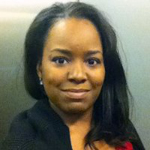
School Of Management Staff Member Is Local School Board President

Like many people in the new School of Management LaSchaunda Smaw has multiple job responsibilities, and her present title as Assistant to Associate Dean Jennifer Contreras doesn’t cover it all. In addition to assisting Jennifer she also manages the office at Masonic, and has been serving as MBAE Recruiting Coordinator. She intends to continue her education in Public Administration at USF. Most interesting, perhaps, is that LaSchaunda — who is the mother of three young children — is also Board President of the Jefferson Elementary School District in Daly City, CA.
We slowed LaSchaunda down a little bit to ask her a few questions about her role on the School Board — and her recent address to the students at graduation.
What is your exact position with the school board? What exactly is a School Board?
I currently serve as Board President. A Board of Education or a School Board is the title of the Board of Directors, or trustees, of a local school district. School board members are elected public officials entrusted with governing a community’s public schools regarding policy and administrative oversight. Our Board consists of five members.
What is the exact school board and where is it located?
Jefferson Elementary School District, Daly City CA
How did you get involved with the board, and how long have you been involved?
When my children began grade school I wanted to be involved in their education, naturally, so I became a part of PTA. However, after serving in various capacities, I realized it didn’t provide me with the opportunity to contribute in the way that I thought was necessary; to effect change I needed more of a voice.
I wanted my children, and all of the children, to have the best possible environment, the safest environment, in which they could get an education, and a preparation for life. I realized that as a member of the School Board I could have a strong voice — especially for children from minority and lower-income families — as well as the upper fringe of very gifted children. Most of the curriculum is geared toward the middle group, with the students on either end often going with their needs unmet.
I was originally appointed to the Board in April 2009, and then elected in November of 2009.
How do you think your work on the board relates to your work here, and to your own aspirations?
Education is important to me. I like working for a great educational institution.
I was raised in a socio-economically challenged community, so I have witnessed firsthand the devastating effect of hopelessness. Education yields opportunity; opportunity breeds hope.
When I was a child there were so many people —teachers, and administrators — who were instrumental in helping me succeed. I want to lend that encouragement to children today. There is an “achievement divide” between students from comfortable and affluent homes, and those from lower income homes. All too often these lower income children have no one who is speaking for them. I want to be a voice for those endangered children because I understand what they’re up against.
No matter what our age or aspirations, education has life-changing implications for us all. My goal on the Board is to ensure students are immersed in a learning environment which supports and promotes their best possible individual achievement. The Board’s role in policy-making is what has motivated me to pursue an education in Public Administration.
We heard that you spoke recently at the Grade School Graduation Exercises. Could you say a little bit about what you said to the students?
I wanted to make my presentation short and to the point. I started out by reading to the students a short poem by Shel Silverstein, called “The Voice:”
That whispers all day long,
“I feel that this is right for me,
I know that this is wrong.”
No teacher, preacher, parent, friend
Or wise man can decide
What’s right for you — just listen to
The voice that speaks inside.
I simply went on to explain to them that there are many external, obvious voices speaking to us. These and many other distractions keep us from hearing the internal voice that can be so important in guiding us.
I encouraged them to remove distractions whenever they can so that they can learn to hear their own internal voice. That’s the voice that they can trust.
Helping them to hear their own inner voices is a very important task to me.